AMD Releases Radeon Software Adrenalin 2019 Edition: Streaming for Videos, Games, & VR
by Nate Oh on December 13, 2018 9:01 AM ESTAdrenalin 2019 Improvements Part 1: WattMan and Performance
While the new Adrenalin 2019 suite puts a heavy emphasis on new streaming features as well as multi-device integration and ease-of-use, some of the existing features have seen some healthy number of tweaks and improvements. WattMan is such an existing feature that brings some larger updates, some of which are Vega-focused.
For Adrenalin 2019, WattMan now features one-click ‘Tuning Control’ presets for overclocking and undervolting, separate from the power-oriented ‘Performance Profile'.
As WattMan is a built-in first-party OC tool, which first-time overclockers and tuners would be most likely to use, these profiles offer a straightforward option for beginners, especially with including an oft overlooked approach with undervolting.
Because WattMan is a built-in first-party OC tool, it’s most likely the first tool that first-time overclockers will fall back to. As such, these new profiles provide a straightforward option for beginners, especially with also providing an option for the often overlooked approach of undervolting the GPU.
While the two overclocking presets are available to RX 400 series and higher, the undervolting profile is limited to discrete RX Vega GPUs. Otherwise, the new Adrenalin 2019 also enables control for all of RX Vega’s DPM states, where as previously only the two highest states were unlocked.
For discrete RX series GPUs, WattMan also brings better fan control by enabling temperature-dependent custom fan curves and also supporting zero RPM. Additionally, WattMan now offers a second preset of video memory timings, intended for optimizing more memory-bound workloads like cryptocurrency mining.
Meanwhile, WattMan has been further integrated into Overlay and AMD Link. With Overlay’s new “WattMan” tab, the Tuning Control presets can be changed on-the-fly, along with loading and saving custom profiles, or even outright manual adjustments of frequencies and voltages.
In the same vein, the aforementioned settings can now also be all adjusted through AMD Link, though by default profile loading is the only modification available. Enabling ‘WattMan Advanced Control’ in AMD Link’s App Settings will permit all the rest of the GPU customization options. Of course, adjustments to potentially unstable settings while in-game may result in unintended consequences.
In line with the new WattMan features to customize efficiency, Radeon Chill is also bringing power-saving improvements to discrete RX GPUs. On the RX Vega, altogether with WattMan enhancements there are now more efficiency-tweaking options for both the entry-level and enthusiast user.
Naturally, AMD reiterates year-over-year performance improvements, though these represent an aggregate over the year rather than arriving all at once with Adrenalin 2019.
Also in this mix is AMD’s ongoing Project Radeon eSports Experience (ReSX), which was first unveiled in March with Adrenalin Edition 18.3.1. Project ReSX focuses on improving performance, 99th percentile frametimes, as well as input latency on the most popular eSports titles. Compared to 18.3.1, AMD is particularly citing the latency reduction enhancements.



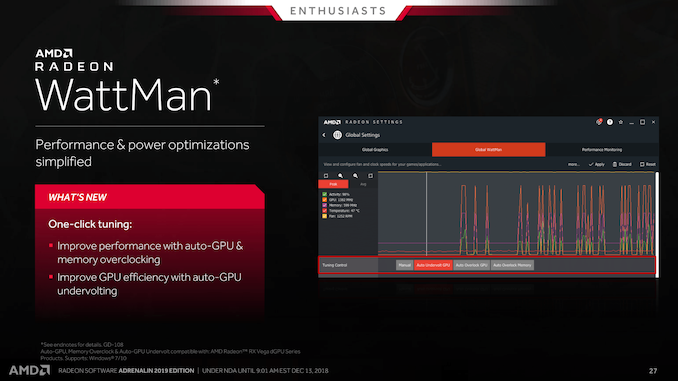
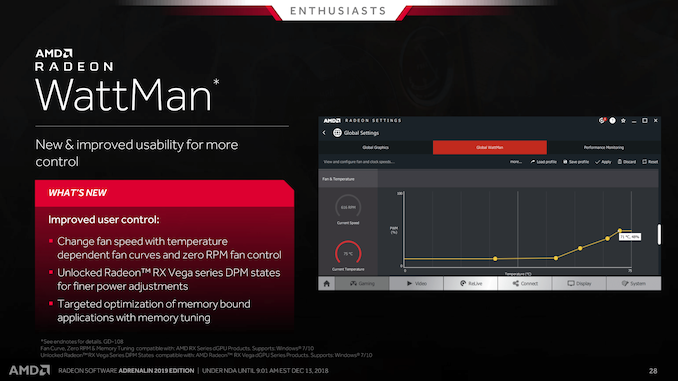
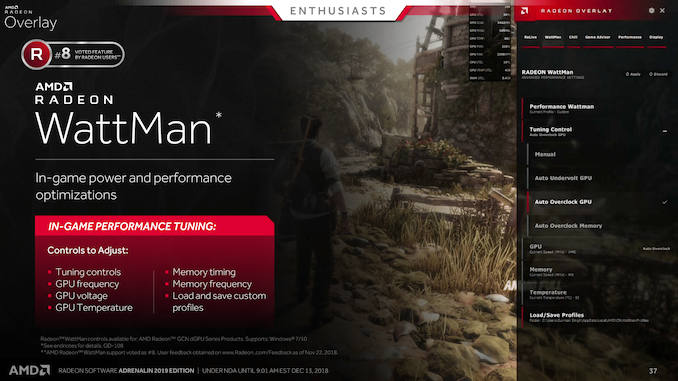
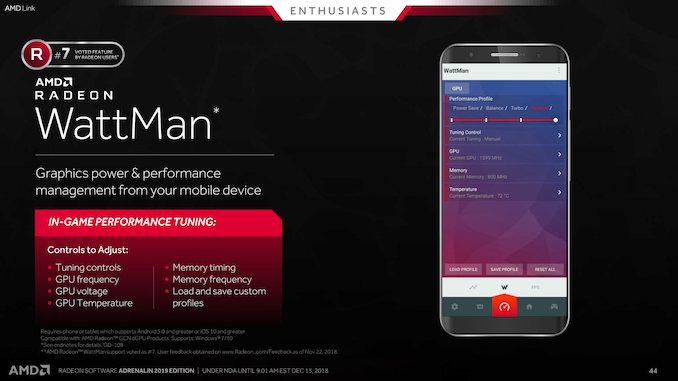
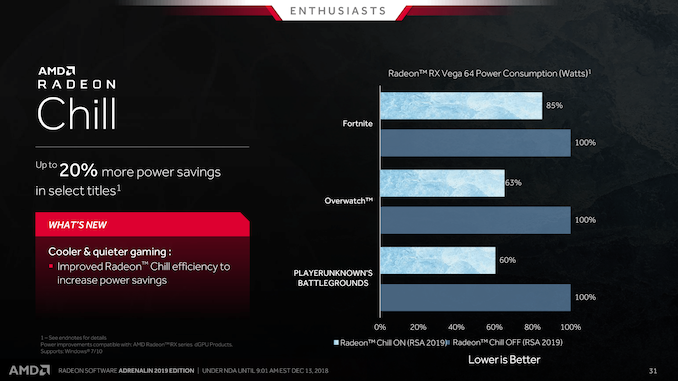
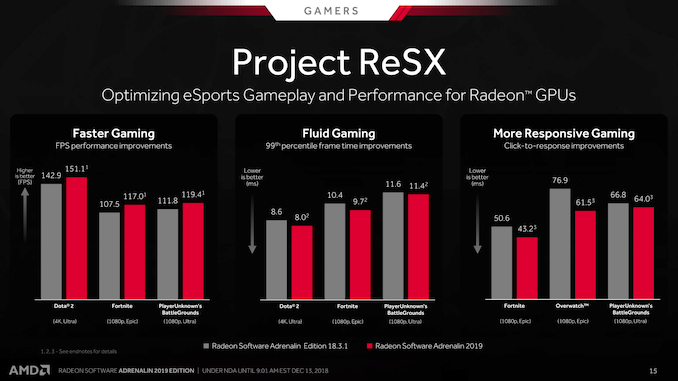








38 Comments
View All Comments
jordanclock - Thursday, December 13, 2018 - link
I'd be really interested to see if AMDs game stream app can be sideloaded to an Nvidia Shield TV. If it works, I would absolutely be in the market for an AMD card.Pablok - Thursday, December 13, 2018 - link
Exactly my thoughts.PhilipJ - Thursday, December 13, 2018 - link
I have to admit that the auto-overclocking & auto-undervolting features being exclusive to the RX Vega lineup of cards is a bit disappointingThough now I can at least stream video games to my phone lol
seamonkey79 - Thursday, December 13, 2018 - link
You're not missing anything. You can only use undervolt OR overclock GPU OR overclock RAM, no combination of the three. They seem to be present profiles, not doing any real testing except to see if the profile works or crashes.Using undervolt, I had no change in voltage.
Using GPU overclock I got 1%.
Using RAM I got 890.
Manually I'm able to far outdo any of those, and wonder of wonders, do all three at the same time.
It's at best a placebo to make some people think they have driver parity with Nvidia. I am sorely disappointed, though I'll admit my expectations were colored by the lack of them saying anything and seeing what Nvidia is capable of doing automatically.
sing_electric - Thursday, December 13, 2018 - link
AMD's previously said that they won't support DirectX Raytracing until they can offer it "in all product ranges." That means I wouldn't expect it in any cards that are on sale today, and possibly not with the first-gen Navi-based cards (the low end of which is rumored to be like a Vega 56). Of course, if the market changes - if RTX becomes essential to a lot of games in the next 2 years, or if Nvidia pulls a rabbit out of its hat and releases a RTX-capable GPU with say, Vega 56-like performance for $200 next year, then I'd bet AMD will do an about face very fast.https://wccftech.com/amds-david-wang-we-wont-imple...
haukionkannel - Thursday, December 13, 2018 - link
They actually did say that DirectX raytracing does not become mainstream until all product rages support it. There has been many not so well translated versions of that interview...But the head of AMD says the obvious that also low end products have to support raytracing until it will be popular...
BertrandsBox - Thursday, December 13, 2018 - link
Really disappointed that we're still not getting a solution for Ryzen Mobile.I bought a laptop with a 2500U in it and to say the driver situation is a mess would be the understatement of the century.
If really hoping they deliver on the promise of delivering more (or even manage a single) update through the OEMs or just deliver it themselves, because if not, they'll have lost a lot of fans on this.
StevoLincolnite - Thursday, December 13, 2018 - link
I have a Ryzen 2700U notebook and I have to agree.Thankfully Lenovo is a little bit ahead of other OEM's though in releasing updates...
evernessince - Thursday, December 13, 2018 - link
AMD can't force the OEM to update and the same goes for Nvidia. This is always a problem for laptops and completely depends on the vendor you buy from.Nothing AMD can do for each and every custom solution and it doesn't make sense for them to be doing other company's work.
limitedaccess - Thursday, December 13, 2018 - link
Nvidia and Intel both provide reference drivers on their website. As far as I know those will work without relying on OEM specific drivers.AMD does the same as well for mobility Radeon products as well as pre-Ryzen APUs mobile or desktop. Only mobile Ryzen APUs starting with Raven Ridge do not have drivers.
I wonder if there is some intrinsic hardware difference/issue that prevents this for mobile Ryzen APUs?